The most numerous grebe species in the world, the Eared Grebe has a somewhat scattered and variable breeding distribution from one year to the next, though it has predictable post-breeding movements. These Eared Grebe migrations take place at night.
When gorging on brine shrimp in the fall, the Eared Grebe’s wing muscles diminish to the point where they can’t fly, and their digestive organs increase to help take on the abundant food. This process reverses in time for the next migration.
The Eared Grebe is a small swimming and diving bird with a compact body, medium length neck, somewhat large head, and a very thin, pointed bill.
Description of the Eared Grebe
BREEDING MALE
The Eared Grebe is a small swimming and diving bird with a compact body, medium length neck, somewhat large head, and a very thin, pointed bill. Breeding birds have a blackish head with a large, bold, golden yellow patch fanning out behind each eye, a black neck and upperparts, and reddish flanks. Length: 13 in. Wingspan: 16 in.

Photograph © Alan Wilson.
Female
Sexes similar.
Seasonal change in appearance
Winter birds have a black cap, black or dusky cheeks, mostly dark or dusky foreneck and dark gray hindheck, and grayish upperparts with whitish flanks.
Juvenile
Juveniles resemble winter adults.
Habitat
Eared Grebes breed on lakes and ponds with emergent vegetation, and winter lakes and salt bays in the southern and western U.S. They are less coastal than the Horned Grebe.
Diet
Eared Grebes dive to capture aquatic prey, primarily insects and crustaceans.
Behavior
Eared Grebes have legs set far back on their bodies, a position that is good for swimming but poor for walking on land. To take flight they must have a running start, paddling furiously through the water while flapping their wings. They are usually seen swimming on the surface, and frequently diving in search of prey.
Range
Eared Grebes breed across parts of western Canada and the western U.S. They winter primarily along the Pacific Coast and in inland waters of the southwestern and south central U.S. They are relatively rare in the eastern U.S. Horned Grebes may be stable, although their population is not well measured.
Wing Shape
The shape of a bird’s wing is often an indication of its habits and behavior. Fast flying birds have long, pointed wings. Soaring birds have long, broad wings. Different songbirds will have a slightly different wing shape. Some species look so much alike (Empidonax flycatchers) that scientists sometimes use the length of specific feathers to confirm a species’ identification.
Wing images from the University of Puget Sound, Slater Museum of Natural History
Eared vs Horned Grebe
The following image shows both Eared and Horned Grebe in winter plumage. Confusing, huh? The Horned Grebe is on the left, and the Eared Grebe is on the right.
The Eared Grebe in this photo has much less white on the face and neck than the bird pictured above. The slight upward curve to the bottom of the bill is more obvious in this photograph. The bill is thinner than the Horned Grebe. In this photograph it is also easy to see the difference in head shape, the Eared Grebe has much more of a peaked head, compared to the flat top the Horned Grebe is sporting.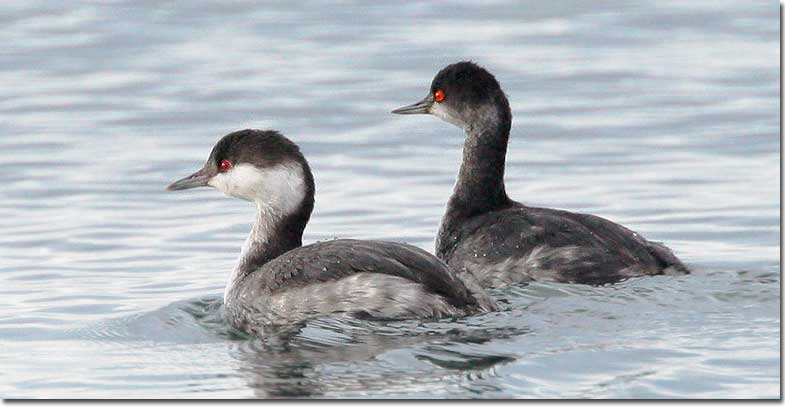
Fun Facts
A Eared Grebe courtship display involves a pair racing vertically across the water with wings partly spread open.
Nearly the entire population of Eared Grebes makes a post-breeding migration to a hypersaline lake such as Great Salt Lake, Mono Lake, or the Salton Sea to feed on brine shrimp.
Young Eared Grebes often ride on their swimming parents’ backs.
Vocalizations
The Eared Grebe’s song is a squeaky whistle, recalling that of the Sora. Calls include a series of shrill cries.
Similar Species
Horned Grebe
Horned Grebes have thicker bills, a reddish neck in summer or a whitish foreneck in winter, and white cheeks in winter.
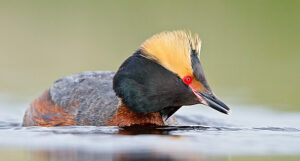
Horned Grebe (Podiceps auritus) in a pond in Saskatchewan, Canada.
Nesting
The nest is a floating pile of plant material placed in shallow water.
Number: Usually lay 3-5 eggs.
Color: Whitish and often stained by nest material.
Incubation and fledging:
The young hatch at about 21 days, and leave the nest shortly after hatching, though they continue to associate with the adults for several weeks.
Photos
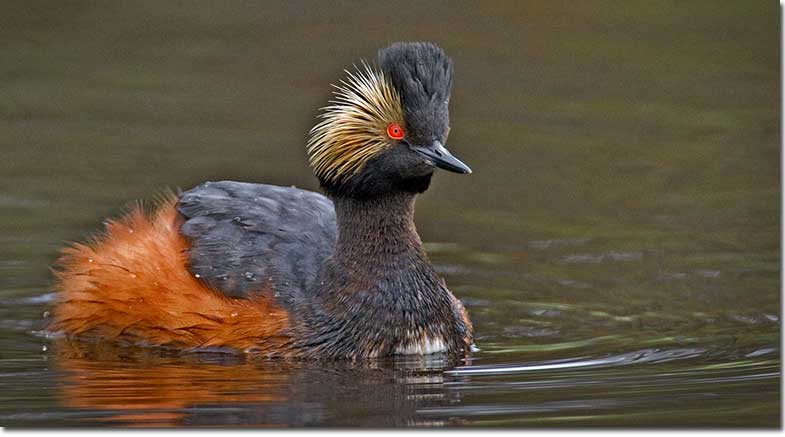
Breeding birds have a blackish head with a large, bold, golden yellow patch fanning out behind each eye, a black neck and upperparts, and reddish flanks. Note the size and shape of the bill. Eared Grebes cab be very colorful. Sexes are similar in appearance. Photograph by Alan Wilson.
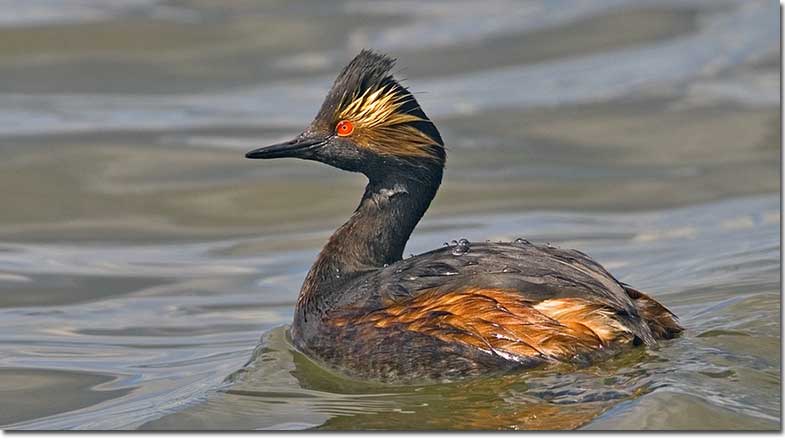
Wet feather day. Photograph by Alan Wilson.
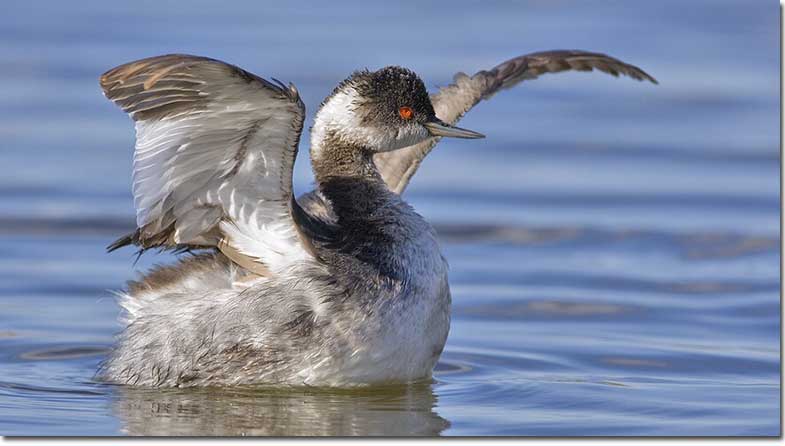
Winter birds have a black cap, black or dusky cheeks, mostly dark or dusky foreneck and dark gray hindheck, and grayish upperparts with whitish flanks. First fall birds similar to winter plumage of adults but may show rust color on the neck. Photograph by Alan Wilson.
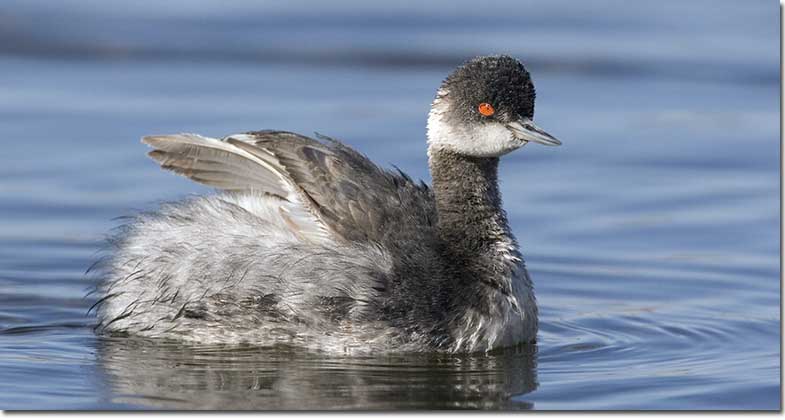
Note red eye, high forehead, and rounded head. This bird seems to show a white spot in front of the eye, a feature on some winter-plumaged Horned Grebes but usually absent from Eared Grebes. Photograph by Alan Wilson.
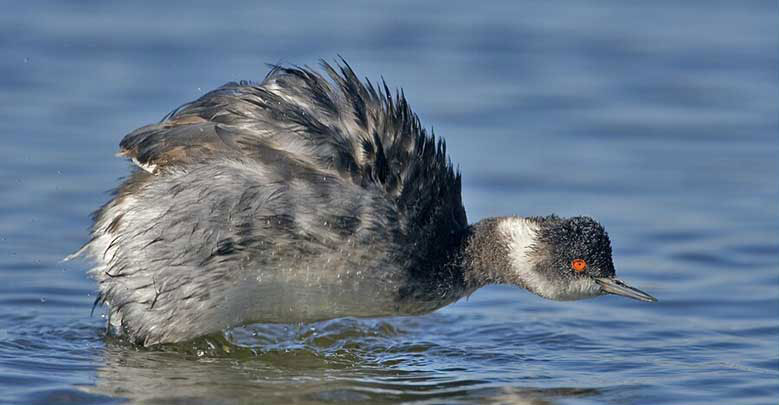
An aggressive stance, not sure who would want to mess with that fine, pointed bill. Photograph by Alan Wilson.
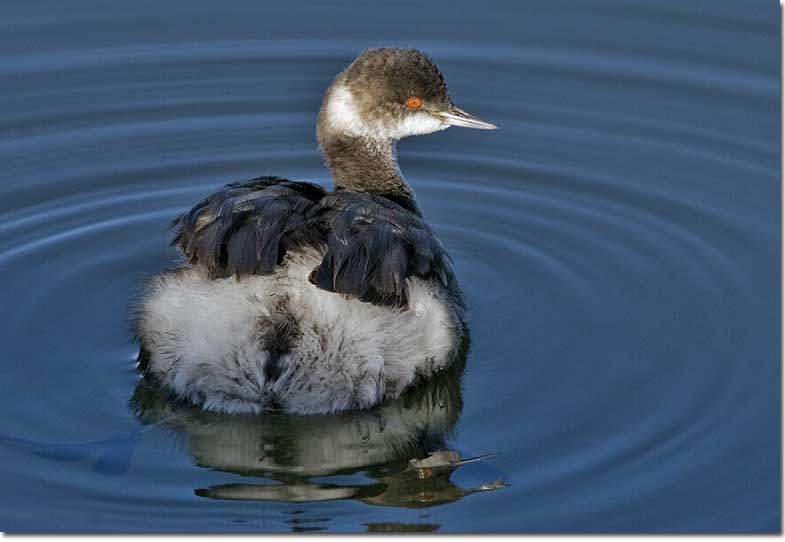
The amount of white on the neck varies, some will have more white, some less. Photograph by Alan Wilson.


